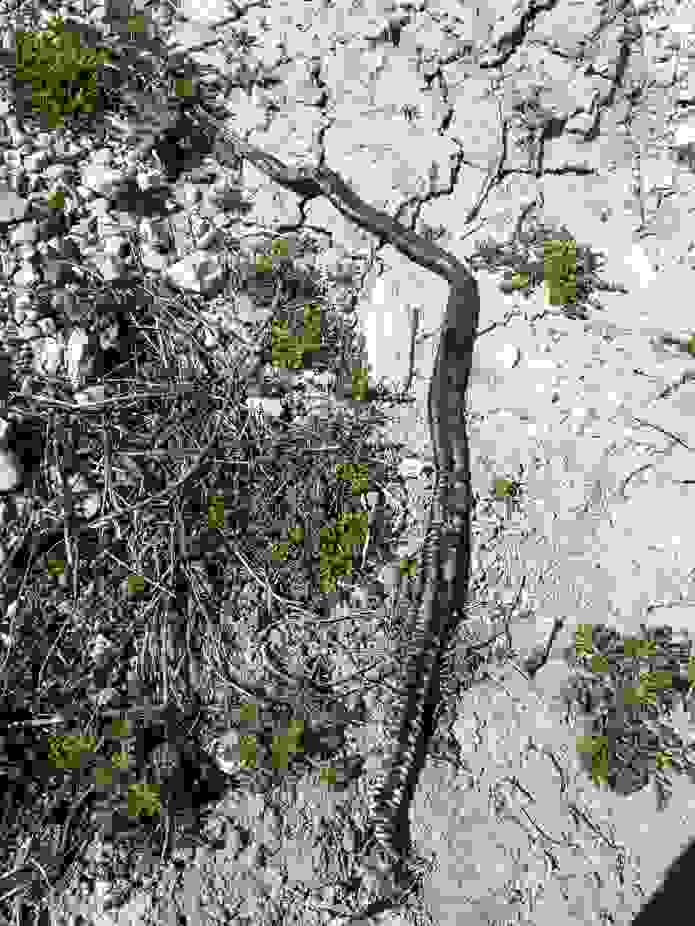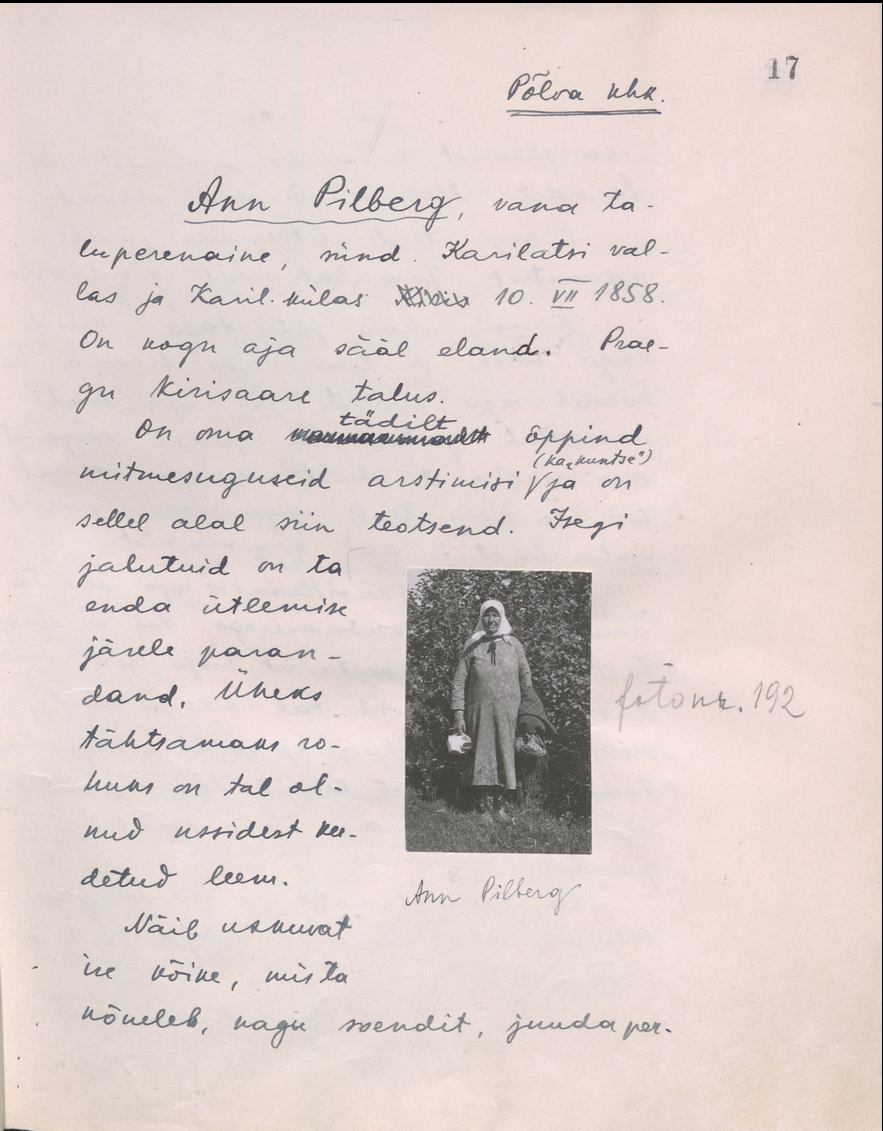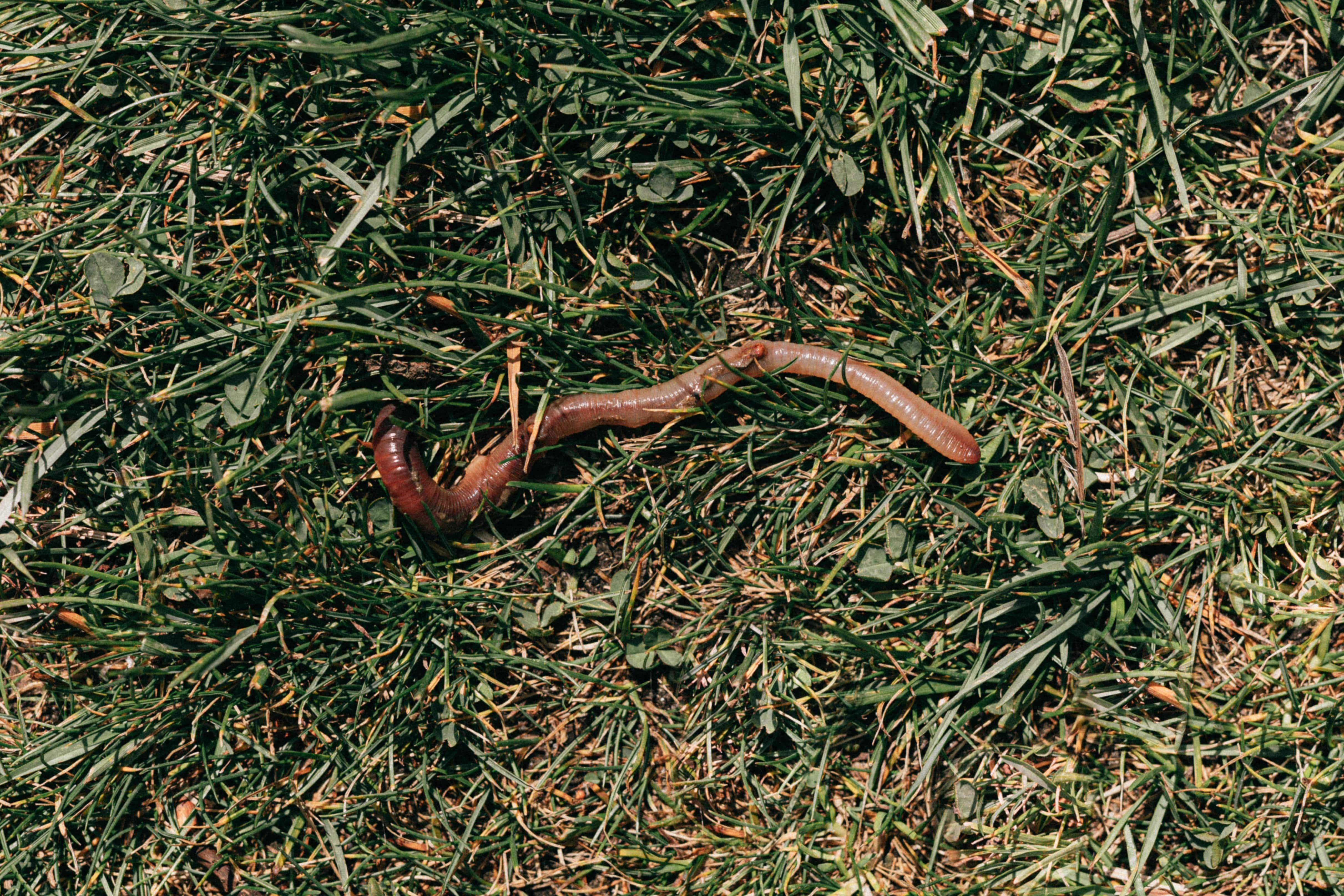Snakes

The snake was not to be killed if it was just called out of the bush.
Ussi tappa ei tohtinud, kui ta muidu poesast välja kutsuti.
Once, a man went on a hunt. Wandering through a great forest, he reached an area of thick pines and came to a hill that was as round as a sugarloaf. The man climbed up the steep hillside until he reached its sharp peak. Here, he saw that bored into the sharp hilltop was a fist-sized hole, from which shone the burning eyes of a snake. The man took a club and killed the snake, which fell bouncing back into the depths. Then, there was a great, strange slithering and hissing that sounded from the bowels of the hill, making the surface of the earth quake.
The man peered down into the pit and saw a horde of snakes surging up. As soon as the snakes came close to the lip, the man bashed the club down upon the snakes’ heads, and clumps of snakes fell back down into the depths of the hill under the strong rain of the man’s blows. Although the man. kept on sending the snakes to their death at the edge of the pit with his heroic strength, new ones kept on surfacing endlessly.
Thus continued the battle for a couple more hours, and the man’s strength was starting to run out. He didn’t dare run away, either, because he feared the snakes would start pursuing him. Therefore, there was no better option than to resist them at the edge of the pit so they couldn’t slither out. The soil of the hill appeared to be chock full of snakes. Suddenly, when the man was about to raise his club to land another blow, a big black snake grandly stuck its head out of the pit, and the man saw that resting upon its head was a fire-red crown that shone with remarkable brilliance. Seeing this, the man dropped his club and, gathering all his strength, he shot like an arrow down the hill and into the thick forest. But as soon as the man reached the forest, the snakes surged after him in countless numbers like the rain. Seeing this, the man threw his rifle at the snakes, which they swarmed around in fury and laid waste to in a few mere moments before starting to chase after the man again.
Then, the man threw down his hat, which the snakes destroyed in turn and then continued chasing after the man. Now, the man threw down his big, new wool coat, which the snakes swarmed again and destroyed as well.
Somewhat by chance, the man came to a field at the edge of the forest where there were stalks of rye. The man started running over them. But here, it wasn’t possible for the snakes to chase the man anymore, because throwing themselves pell-mell forward, the snakes were lanced by the sharp stalks, and many were even killed. Seeing this, the others turned back towards the forest and sank into the woods like a roiling current. The man thus fortunately escaped the kingdom of the snakes. He never dared to go hunting there again, or to otherwise walk there. He warned others about that sugarloaf-like hill as well.
Kord käinud üks mees jahil. Mööda suurt metsa uidates jõudnud ta ühe paksu laane sisse ning jäi mäe juurde, mis olnud ümmargune kui suhkrupea. Mees ronis mööda liusakat mäekülge kuni mäe terava tipuni üles. Siin nägi ta, et teravast mäetipust läks rusikasuurune auk mäe sisse, kust ühe ussi põlevad silmad välja kiirgasid. Mees võttis vembla ja lõi ussi surnuks, see kukkus patsatades alla sügavusesse. Selle peale oli all mäepõues imelikku suurt kihinat ja kohinat kuulda, nõnda et mäepind aina värisenud. Mees vaatas august alla ja nägi hulka usse ülespoole tulevat. Niipea kui ussid pea augu äärele saanud, langes mehe vemmal plaksatades usside pähe ja nagu rahet langenud ussipuntraid mehe tugevate hoopide all mäe sügavusesse tagasi. Ehk mees küll kangelase jõuga usse augu äärel muudkui surma saatnud, tulnud ikka ühtelugu uusi alt üles.
Nii kestis võitlus paar tundi edasi ja mehel oli jõud juba lõppemas. Ära ei ole julgenud ka joosta, sest ta kartis, et ussid teda taga hakkavad ajama. Sellepärast ei ole enam muud paremat nõu olnud, kui augu ääre peal vastu panna, et nad välja ei saaks tulla. Mäepind paistis puha usse täis olevat. Järsku, kui mees tahtis jälle oma vemmalt löömiseks üles tõsta, pistis üks suur must uss pea uhkelt august välja ja mees nägi, et ussi pea peal on tulipunane kroon, mille ümber kumas iseäralik hiilgus. Mees lasi seda nähes vembla maha langeda ja pistis kogu jõudu kokku võttes nagu nool mäest alla ja paksu metsa sisse. Aga niipea kui mees metsa sai, visanud ussisid määratumas summas nagu vihm mehele metsa järele. Seda nähes paiskas mees usside poole oma püssi, mille ümber ussid kanges vihas hunnikusse kargasid ja selle mõne silmapilguga pihuks ning puruks tegid ning uuesti mehele järgi ajama pistsid. Siis viskas mees mütsi maha, mille ussid jällegi puruks tegid ja mehele järgi ajama pistsid. Nüüd viskas mees oma suure uue villase kuue maha, mille kallale ussid jällegi kargasid ja sellegi puruks tegid.
Poolkogemata jõudis mees metsa äärde väljale, kus rukkikõrred olid. Mees hakkas neist üle jooksma. Aga siin ei olnud ussidel enam võimalik meest taga ajada, sest rataskuuti pildudes viskasid ussid end teravate rukkikõrte otsas katki ja selle läbi said paljud surmagi. Teised pöörasid seda nähes ära metsa poole tagasi, ja nagu kihav veevoog vajus metsa sisse. Mees pääses nõnda siis õnnelikult usside kuningriigist välja. Enam ealeski ei julgenud ta sinna jahile ega ka muidu minna. Teisigi hoiatanud ta selle suhkrupeasarnase mäe eest.
A poisonous snake1 sings like a grasshopper. I have heard it myself. He stands up at a tree when singing but his voice is more plain than that of a grasshopper.
1 Viper, lit. ‘needle snake’ here.
Nõeluss laulab nagu rohutirts, seda ma olen ise kuulnud. Uss on püsti puu naeal, kui laulab, aga tal on lamedam ääl kui rohutirtsul.
Poisonous snake (lit. needle snake) sings mostly when it wants to go inside someone. It would be singing more or less like a grasshopper: chirp, chirp, chirp. People nowadays don’t believe anything anymore, but the snake may get angry at someone, then get up and run after them. Sometimes it throws itself in a ring in the air and follows you. Then it may want to jump at your neck and when you forget that your mouth is open while running, it climbs straight into your mouth. When I was a young man, a young girl was buried in Koeru Chapel. People said that the snake had been running after the girl for so long that she got tired, and then it climbed into her mouth and thereafter the girl died. But other people told that there had been one man who wanted this girl but she did not want him, and so he let a witch send a snake after her to get into her and kill her.
Nõeluss laulab enamasti siis, kui ta tahab kellegile sisse minna. Ta laulvat umbes nagu rohutirts, ikka sirts, sirts, sirts, jn. Nüüdse aja inimesed ei usu enam midagi, ega usta kedagi. Mõne inimese piale ta saavat vihaseks, siis ajavat teine kohe püsti ka jookseb järele ka. Vahest viskab ennast kohe rõngas õhus sinule järele, siis tahtvat kaela karata ja kui sa jooksmisest suu lahti unustad ronib kohe suhu. Kui mina alles noormees olin, siis maeti Koeru kabelis ühte noort tüdrukud, siis rahvas rääkis, et ajand ka tüdrukud nii kaua taga, kui see ära väsind ja siis läind suhu ja tüdruk surnd siis selle pärast ära. Mõned rääkisid siis jälle nii, et olnd üks mees, kes taht seda tüdrukud ja tüdruk põle teda taht, siis see mees oli last nõiduda nõida ühte ussi, kes ta sisse läks ja ta ära tappis.
After the Nativity of Mary2 it was said that now you can go to the forest because the snakes have gathered and have started going into the sod. So, there is no need to be afraid of snakes in the forest.
2 In Estonian lit. ’Feast of Mary of the Snakes’ Sept 8.
Ussimaarjapäeva järel öeldi, et nüüd võib metsa minna, et nüüd on ussid löönud punti ja minema mätta sisse, siis ei ole metsas enam ussi karta.

Ann Pilberg was born in Karilatsi parish and village in 1858 [---]. This old farm hostess has learned various traditional ways of healing, including "the arts" [of witchcraft], from her aunt, and has been providing health care for local people. She says that she has even cured cripples. One of her most important medicines is a broth boiled from snakes.
She seems to believe everything, that she talks about, such as werewolves, following the Devil, seeing ghosts, etc. She claims having been seen a werewolf. She firmly believes in God and is known as an adventist.
She is a rather good narrator, but it is quite difficult to restrain her. She speaks very fast and loves to tell long stories about her personal life. By the way, she had a son, who was shot as a communist during the Estonian war of independence.
She was weaving on a loom almost all of our conversation.
Ann Pilberg, vana taluperenaine, sünd Karilatsi vallas [ja külas 1858 ---]. On oma tädilt õppind mitmesuguseid arstimisi (ka "kuntse") ja on sellel alal siin teotsenud. Isegi jalutuid on ta enda ütlemise järele parandand. Üheks tähtsamaks rohuks on tal olnud ussidest keedetud leem.
Näib uskuvat kõike, mida kõneleb, nagu soendit, juuda perra olemist1, vaimude nägemist jne. Soendit ütleb ise näinud olevat.
Praegu teiste ütlemise järele adventist. Jumalat usub kindlasti.
Kaunis hää jutustaja, kuid väga raske on teda vaos hoida. Ta kõneleb väga kiiresti ja väga tihti armastab jutustada pikki lugusid oma isiklikust elust. Muuseas olevat tal üks poeg Eesti vabadussõja päevil maha lastud kui kommunist.
Pea kogu küsitlemise aja oli ta ametis kangakudumisega.
1 Kuradi moodi olemine, kuradi järgi käimine – selle täpsem tähendus ei ole selge, võibolla mingi vaimne probleem.
A woman went to prepare young leafed branches . She saw a snake having babies, and she was thinking to herself that the snake also has the suffering of a woman in delivery. Thereafter something is taken to such women, but who would give something to the snake? The woman had a sandwich with her. She split it into two and gave half to the snake. Thereafter some time passed; a long time passed. One day this woman went to the sauna with her old mother and her children. While she was in the sauna she saw a snake come in from under the wall with a rouble coin in her mouth. She had come to give a rouble coin to the woman who had given her a sandwich when she was in delivery.
Naine läinud lehiseid tegema. Näinud, et uss poegib. Mõtelnud endamisi, et näe, temal ka tarenaise (nurganaise) haigus. Siis ikka käiakse ja viiakse midagi, kes temale viib? Olnud naisel võidleiba ka ühes. Murdnud siis võiuleiva pooleks ja viinud ussile. Läinud siis aega mööda, kuipalju läinud. Lehesel käija naine läinud oma vana emakese ja lastega sauna. Olnud parajasti saunas, kui näinud, et uss tuleb müüri alt sisse, rublatükk suus. Ta tuli sauna toda rublatükki naisele tooma selle eest, et naine talle sünnitamise aegu võidleiba andis.
When Noah went to the Ark before the flood, he took along all kinds of animals with him but he did not take the poisonous snake1. When during the flood, the Ark set sail, the poisonous snake pressed himself into a gimlet hole in the bottom of the Ark that Noah had forgotten to close, and this is how the snakes survived on the earth.
1 Viper, lit. ‘needle snake’ here.

